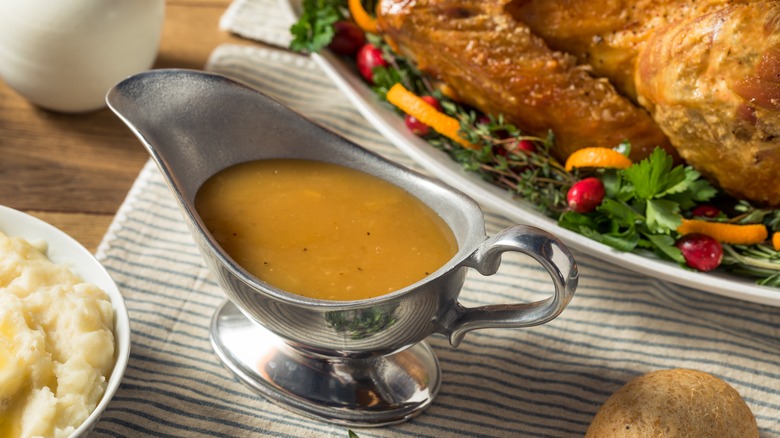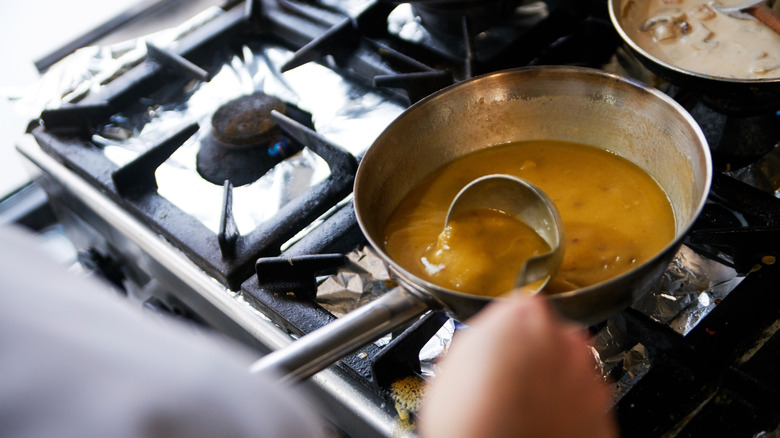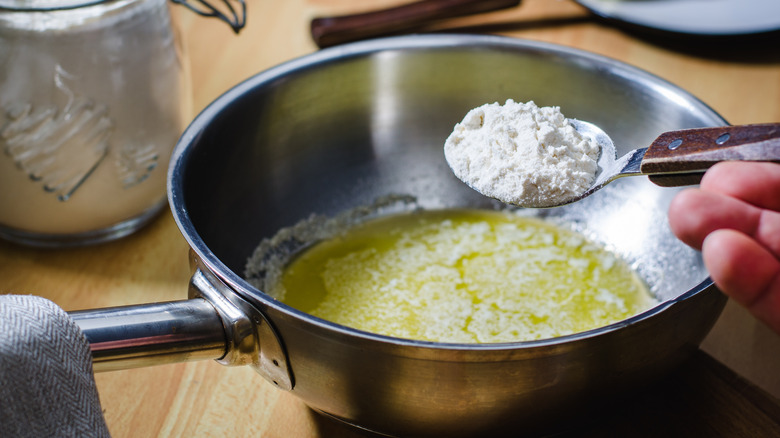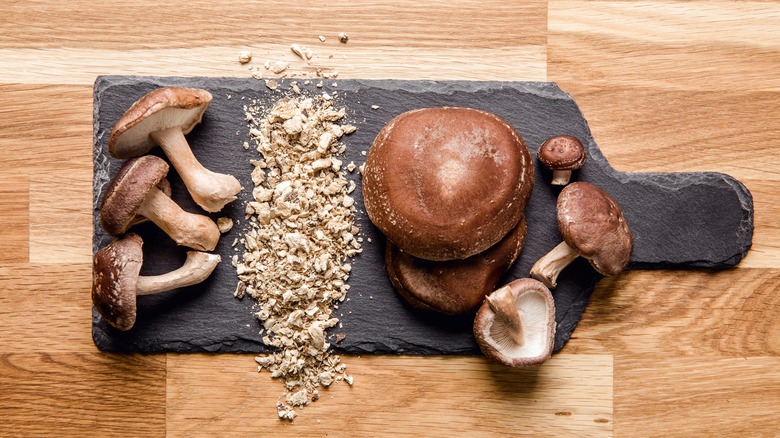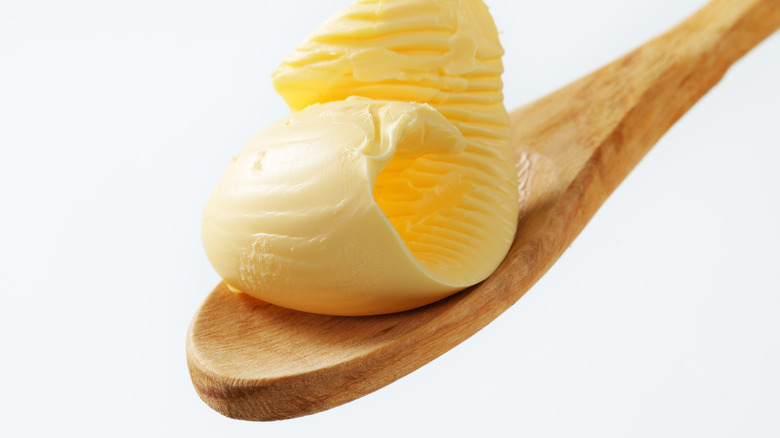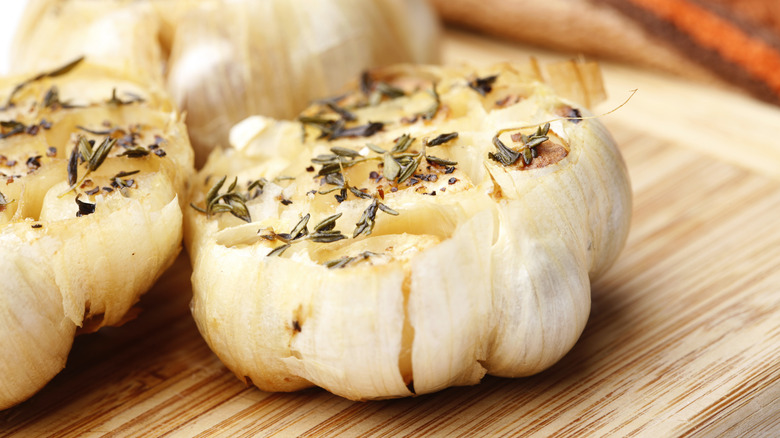8 Hacks To Elevate Your Jar Of Turkey Gravy To Homemade Gourmet, According To Home Chefs
While it may sometimes seem like an afterthought, gravy can shape a dish, particularly when it comes to a Thanksgiving turkey. Typically made with the drippings and juices from roasting a turkey, a thickening agent, and seasoning, gravy can be as elaborate or as simple as your preferences. While many of us enjoy making gravy from scratch, convenience is important, especially during the hustle and bustle of holiday meal preparation. After all, the last thing you want is a lumpy gravy disaster on your dining table.
If you find yourself short on time or simply prefer a straightforward approach, consider amping up a pre-made gravy to streamline your meal preparation. Start by tasting your store-bought gravy. If it seems too bland or overly runny, there are several easy steps you can take to enhance its flavor and texture. To help you in your quest, we have scoured the internet for top-notch gravy advice from experts and home chefs. We are sure that with a bit of creativity and some pertinent advice, you can easily transform a basic store-bought gravy into a culinary masterpiece that will impress your dinner guests.
Ready to take your pre-made gravy to the next level? Check out these eight hacks to elevate your jar of turkey gravy to homemade gourmet!
1. Incorporate turkey pan drippings
Turkey pan drippings are the flavorful liquid that accumulates at the bottom of a pan while a turkey is being roasted. As the turkey cooks, it releases a combination of fat and meat blood, which contains a lot of the bird's natural flavor. They're also usually filled with delicious seasoning and herbs used to enhance the turkey's taste during the roasting process. While pan drippings are frequently used as a base for making gravy from scratch, when you're short on time, their rich flavor can also be used to boost the gastronomic appeal of a store-bought gravy.
To get as much pan drippings as possible, Delighted Cooking recommends placing the turkey on a rack during roasting since meat tends to reabsorb juices. If there are any hardened bits of turkey on the pan, don't wash them off since they frequently store the most flavor. Instead, TODAY suggests covering them with chicken broth or wine and placing the pan over medium-high heat. Once the brown bits have loosened, remove the layer of fat from the pan juices and integrate the mixture into your sauce.
2. Add a splash of alcohol
It's no secret that alcohol can add depth to the flavor and aroma of food. Wine, beer, and spirits are frequently used for creating flavorful sauces and tenderizing meat through marinades. When it comes to enhancing jarred gravy for your turkey, a little alcohol can go a long way. A couple of tablespoons of your favorite tipple won't just elevate the flavor of your gravy but can also let you put your own unique spin on a generic product.
Generally, when it comes to meat, white wine works best with poultry gravy, while red wine is commonly used in gravy for beef or pork. When enhancing the flavor of your Thanksgiving gravy, In Good Taste recommends opting for crisp, dry wine such as sauvignon blanc, pinot grigio, or dry chardonnay. Avoid fruity wines such as riesling, as they can caramelize and make your gravy overly sweet.
If you're not a fan of wine, opt for a splash of liquor such as brandy or sherry. For instance, American television chef and author, Ina Garten likes to personalize her Thanksgiving gravy with a touch of cognac. According to In Good Taste, the best way to infuse your gravy with a boozy twist is to add it to the mix as you're simmering it over low heat. This is because the heat will cause the alcohol to evaporate and eliminate any unwanted sharpness in the flavor.
3. Thicken it with a cornstarch or roux
If you find that the addition of pan drippings to your store-bought gravy has made it overly runny, don't despair. Thickening a gravy is the proverbial walk in the park — as long as you know what you're doing, that is. One way to thicken a gravy is to let it simmer over low heat. The only potential downside to this method is that it can leave your gravy a little salty since it reduces the water-to-salt ratio.
Other commonly used methods to save overly runny gravy involve thickening agents. Many chefs thicken gravy with a cornstarch slurry, which involves mixing one tablespoon of cornstarch for each cup of cold water. This paste is then slowly stirred into the gravy as it simmers on low heat. If you don't have cornstarch, you can substitute it with tapioca flour, arrowroot powder, or potato starch. Another method of thickening gravy involves roux, a combination of cooked butter or oil and all-purpose flour that's added to sauces to make them less runny.
If your gravy becomes too thick — this can sometimes happen if you leave the condiment in the fridge overnight, don't worry. Just as you can thicken overly thin gravy, you can also readily adjust overly thick gravy to your preferred consistency. For best results, dilute the gravy with turkey stock, chicken broth, or water.
4. Give it a kick with a little mustard
While most of us associate mustard with hot dogs and hamburgers, this versatile condiment can elevate a wide range of dishes. Its unique combination of tangy, slightly spicy, and creamy flavors makes it a perfect companion for many culinary creations. And gravy is no exception. Whether drizzled over turkey or side dishes, gravy infused with a little mustard can add a tantalizing zing to a Thanksgiving dining experience.
There are many different types of mustard on the market that can be used to change the flavor profile of your jar of turkey gravy. As long as you keep in mind that different mustards come with different potency levels, the culinary world is your oyster. Here are just a few examples. Made with mustard seeds and white wine, Dijon mustard has a pungent and spicy flavor that's perfect for homemade sauces — or enhancing a store-bought gravy. To add a little texture to your sauce, opt for a whole-grain mustard. There's also honey mustard for those who like their gravy on the sweet side and spicy brown mustard for those who like their sauces with a little kick. And if you're unsure which mustard to opt for, you can always rely on the crisp and slightly tangy flavor of classic yellow mustard.
5. Simmer it with umami-flavored ingredients
Food has five basic flavors: sweet, sour, salty, bitter, and umami. Translating to "pleasant savory taste" in Japanese, umami has been described as meaty or brothy. Monosodium glutamate, commonly known as MSG, is frequently incorporated into dishes to enhance their umami taste. Luckily, you won't need to scour your local grocery store for MSG to add a hint of umami to your jar of gravy.
There are probably plenty of umami-rich ingredients already sitting in your kitchen pantry or refrigerator. Some of these include mushrooms, caramelized onions, black garlic, bacon, and prosciutto. Many popular condiments are packed with umami flavor and can easily make their way into your gravy. These include soy sauce, Worcestershire sauce, and miso paste. This being said, you need to proceed with caution if you don't want to overpower the other flavors in your gravy with umami. Instead of throwing all your umami-rich ingredients into the gravy at the same time and hoping for the best, add them little by little. Let them simmer, taste the gravy, and only add more if required.
6. Add a little butter
There's a good reason why so many gravy recipes call for butter. Butter is rich in fat, which can amplify the taste of other ingredients in a dish. Additionally, butter's creamy texture and subtle sweetness can create a pleasant mouthfeel and mellow out any intense flavors in food, including sauces. Butter can make a particularly delicious addition to gravy if you don't have a lot of pan drippings that can be mixed into the sauce.
Adding a spoonful of butter to store-purchased gravy can take it from ordinary to, well, extraordinary. For best results, brown a little butter on a pan before mixing it into the gravy. This is because simmering butter over medium heat separates butterfat and milk solids from water, giving it a deliciously nutty and toasty flavor. The butter should turn from bright yellow to golden brown — anything darker means that it might have burned. It is also advised to use a pan with a light-colored bottom when simmering the butter so you can easily see its color.
7. Infuse it with fresh herbs and roasted garlic
Simmering a store-purchased turkey gravy with fresh herbs is a fantastic way to infuse it with flavor. All you have to do is choose a combination of fresh herbs that complement the flavors of your turkey and the rest of your meal. As noted by LiveStrong, some of the more popular additions to chicken and turkey gravy include lighter herbs such as rosemary, sage, oregano, and thyme. You can also add a few sprigs of fresh marjoram or tarragon, or a little ginger and paprika, for a more unique twist. Don't forget to strain the aromatics before serving the gravy.
If you're roasting your turkey in the oven, why not throw a few cloves of garlic into the mix? While raw garlic is overly pungent for gravy, roasted garlic is much softer and milder in flavor, making it an excellent complement to sauces. To make roasted garlic, the Tasting Table recommends removing its outer peel and slicing off ¼ of the stem side of the bulb. Once drizzled with olive oil and seasoned with salt and pepper, wrap the bulb in aluminum foil and roast it at 375 degrees Fahrenheit for 45 minutes. After the roasted garlic cools down, simply squeeze it out of the skins, mash it up, and incorporate it into the gravy. To ensure that your gravy is as smooth as possible, pop the final mixture into a blender.
8. Mix in a splash of milk or cream
A touch of creaminess can impart your gravy with a velvety mouthfeel that elevates the overall dining experience. Milk or heavy cream can also help to balance the flavors in the gravy, especially when dealing with intense or overly salty profiles. And if you think that adding cream to your gravy will make it too sweet, think again. While frequently incorporated into dessert, the mild sweetness of heavy cream is unlikely to change the flavor profile of your gravy.
According to Kitchen Seer, when it comes to gravy recipes, milk and heavy cream are pretty much interchangeable. In fact, a lot of chefs opt for heavy cream instead of milk since it makes the gravy both thicker and more velvety in texture. Alternatively, some cooks use half-and-half (a mix of whole milk and cream) to add creaminess to their turkey gravy. Whatever you opt for, it's important to note that improper mixing of dairy with other gravy ingredients may lead to curdling, so be sure to give the mixture a good stir.
